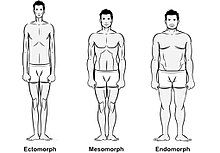William Herbert Sheldon
Lieutenant Colonel William Herbert Sheldon | |
|---|---|
 | |
| Born | November 19, 1898 Warwick, Rhode Island, United States |
| Died | September 17, 1977 (aged 78) Cambridge, Massachusetts, United States |
| Alma mater | Brown University (BSc) University of Colorado (MSc) University of Chicago (Ph.D & M.D) |
| Occupation(s) | Psychologist and eugenicist |
| Employer(s) | Harvard University (Formerly) Columbia University (Formerly) University of Chicago |
William Herbert Sheldon, Jr. (November 19, 1898 – September 17, 1977) was an American
Early life and education
Sheldon was born in
Gaining a two-year fellowship in Europe allowed him to study under
From 1947 to 1959 he was Director of the Constitutional Laboratory at the
Work

In psychology, he developed a new version of somatotypology by classifying people into endomorphic, mesomorphic, and ectomorphic types, based on many photographs and measurements of nude figures at Ivy League schools.[4] Ron Rosenbaum writes: "He believed that every individual harbored within him different degrees of each of the three character components. By using body measurements and ratios derived from nude photographs, Sheldon believed he could assign every individual a three-digit number representing the three components, components that Sheldon believed were inborn -- genetic -- and remained unwavering determinants of character regardless of transitory weight change. In other words, physique equals destiny."[1]
Sheldon also argued that physique was closely correlated with temperamental viscerotonic patterns that powerfully influenced attitudes to food, comfort and luxury, ceremoniousness, sociability, nostalgia, pain, and a great variety of other aspects of human experience. Aldous Huxley took a considerable interest in and popularized knowledge of Sheldon's work, writing that "Sheldon has worked out what is, without question, the best and most adequate classification of human differences," [6] and Sheldon's concepts influenced Huxley's understanding of himself, friends and family, characters in his own work and the work of others, various historical figures, and even entire schools of philosophy and religions.[7]
Numismatic Work
In numismatics, William Sheldon authored Early American Cents and later revised that work within Penny Whimsy (these were the most exhaustive catalogues of the varieties of
Theft and posthumous lawsuits
William Herbert Sheldon was also a specialist in United States cents. After his death, he was accused by the American Numismatic Society (ANS) of substitution of lower grade examples of his cent coins with high grade examples from the cabinets of the ANS.[9][10] In all, he substituted 129 coins from the ANS for ones from his personal collection, and since then, the coins have gradually been returned by fellow collectors who have purchased them unknowingly.[11]
Death
Sheldon died in his office at the Biological Humanics Center in Cambridge, Massachusetts, on September 17, 1977.[5] He is buried at Pawtuxet Burial Yard in Warwick, Rhode Island.
Publications
- — (1936). Psychology and the Promethean Will. Harper & Brothers.
- — (1940). The Varieties of Human Physique (An Introduction to Constitutional Psychology). Harper & Brothers.
- — (1942). The Varieties of Temperament (A Psychology of Constitutional Differences). Harper & Brothers.
- — (1949). Varieties of Delinquent Youth (An Introduction to Constitutional Psychiatry). Harper & Brothers.
- — (1949). Early American Cents, 1793–1814. Harper & Brothers.
- — (1954). Atlas of Men. Harper & Brothers.
- — (1958). Penny Whimsy. Harper & Row.
See also
References
- ^ New York Times. Archivedfrom the original on 2007-03-11. Retrieved 2008-03-11.
- New York Times. January 21, 1995. Archivedfrom the original on May 6, 2020. Retrieved December 1, 2011.
Later, other photographs were taken by W. H. Sheldon, a researcher who believed that there was a relationship between body shape and Temperament traits. Mr. Sheldon has since died.
- ^ Margaret Alic (6 April 2001), "Sheldon, William Herbert (1898-1977)", Encyclopedia of Psychology, archived from the original on 4 January 2010, retrieved 12 December 2011
- ^ Psychiatric Bulletin. Archived(PDF) from the original on 2020-01-26. Retrieved 2011-12-07.
- ^ a b "William H. Sheldon, 78. Correlated Physiques and Traits of Behavior. Headed Research Center". The New York Times. September 18, 1977. Archived from the original on 2017-10-17. Retrieved 2007-07-21.
- ^ Aldous Huxley, The Perennnial Philosophy (New York: Harper & Row/Harper Colophon, 1970; originally published 1945), p. 149; see also essays collected in Themes and Variations (1950).
- ^ Philip Thody, Aldous Huxley: A Biographical Introduction (New York: Charles Scribner's Sons, 1973), pp. 98-99.
- ^ "Grading Coins". Archived from the original on 2006-02-04. Retrieved 2009-09-30.
- ^ ANS search for 129 missing cents becomes legal battle: Society attorney names late William Sheldon as suspect," by Bill Gibbs, Coin World Aug. 23, 1993; ANS Magazine, vol. 3. no. 2, Summer 2004, by ANS curator Robert W. Hoge
- ^ "More on Collector Ted Naftzger and the Switched Large Cents," by John Kleeberg, The E-sylum, Vol. 11, No. 24, June 15, 2008, Article 17.
- ^ Gibbs, William T. "Husak family returns missing Clapp cent to the ANS". coinworld.com. Amos Media Company. Retrieved 24 March 2024.
Further reading
- Gardner, Theories of personality (John Wiley & Sons Inc, 1959), pp. 336-377 (Sheldon's constitutional psychology.) - includes biography of Sheldon
- Physique as Destiny: William H. Sheldon, Barbara Honeyman Heath and the Struggle for Hegemony in the Science of Somatotyping
- "The varieties of Temperament", Harper & Brothers Publishers, 1942. downloadable versions: https://archive.org/details/TheVarietiesOfTemperamentAPsychologyOfConstitutionalDifferences
